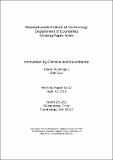| dc.contributor.author | Acemoglu, Daron | |
| dc.contributor.author | Cao, Dan | |
| dc.date.accessioned | 2012-07-05T23:11:11Z | |
| dc.date.available | 2012-07-05T23:11:11Z | |
| dc.date.issued | 2010-09-12 | |
| dc.identifier.uri | http://hdl.handle.net/1721.1/71539 | |
| dc.description.abstract | We extend the basic Schumpeterian endogenous growth model by allowing incumbents to undertake innovations to improve their products, while entrants engage in more “radical” innovations to replace incumbents. Our model provides a tractable framework for the analysis of growth driven by both entry of new firms and productivity improvements by continuing firms. Unlike in the basic Schumpeterian models, subsidies to potential entrants might decrease economic growth because they discourage productivity improvements by incumbents in response to reduced entry, which may outweigh the positive effect of greater creative destruction. As the model features entry of new firms and expansion and exit of existing firms, it also generates a non-degenerate equilibrium firm size distribution. We show that when there is also costly imitation preventing any sector from falling too far below the average, the stationary firm size distribution is Pareto with an exponent approximately equal to one (the so-called “Zipf” distribution”). | en_US |
| dc.publisher | Cambridge, MA: Department of Economics, Massachusetts Institute of Technology | en_US |
| dc.relation.ispartofseries | Working paper, massachusetts Institute of Technology, Dept. of Economics;10-12 | |
| dc.rights | An error occurred on the license name. | en |
| dc.rights.uri | An error occurred getting the license - uri. | en |
| dc.subject | Innovation | en_US |
| dc.subject | Entrants | en_US |
| dc.subject | incumbents | en_US |
| dc.title | Innovation by Entrants and Incumbents | en_US |
| dc.type | Working Paper | en_US |
